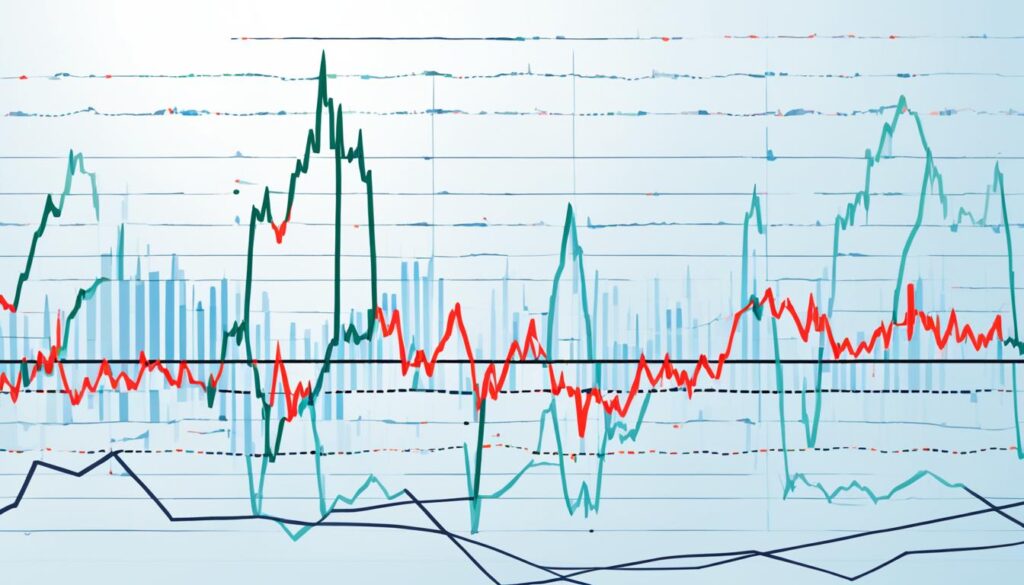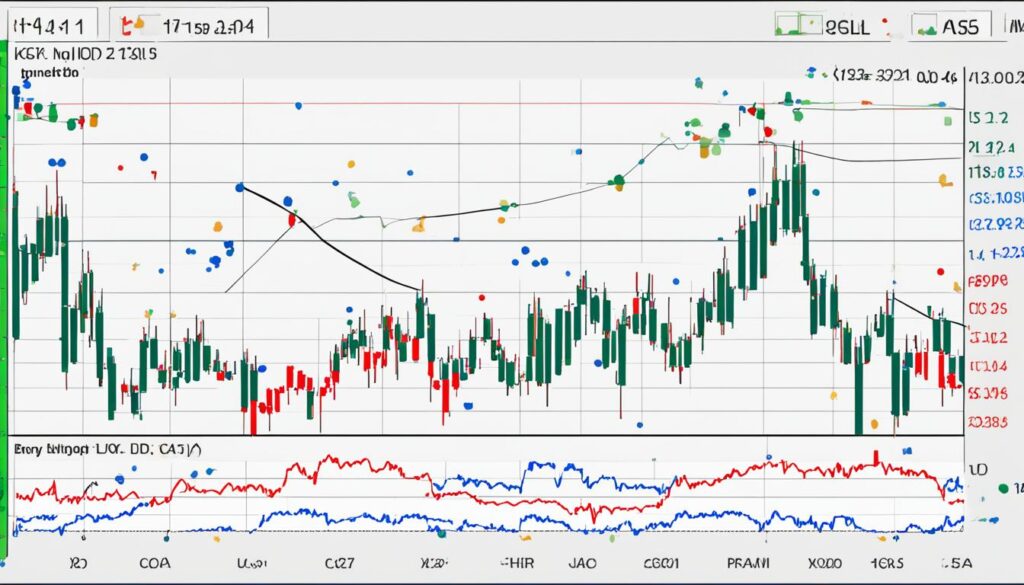As a professional in the world of stock trading, I understand the importance of making informed decisions quickly and efficiently. That’s why I rely on the KDJ indicator, a powerful technical analysis tool that has significantly improved my decision-making process. In this article, I will demystify the KDJ indicator, explaining how it can enhance your stock trading strategy and increase your chances of success.
The KDJ indicator is a widely used tool in technical analysis, specifically designed for stock trading. Its primary purpose is to predict price reversals in the stock market, based on the principles of momentum and volatility. When configured correctly, the KDJ indicator has shown an impressive 63% success rate, making it an essential tool in any trader’s arsenal. However, it’s important to note that improper setup can lead to unreliable results and potential losses, underscoring the need for accurate interpretation.
So, what exactly is the KDJ indicator, and how does it work? The KDJ indicator is an oscillating stochastic indicator that analyzes stock prices by considering three key components: %K, %D, and the J Line. %K represents the current price level relative to recent highs and lows, while %D is a smoothed version of %K. The J Line is a derivative of %K and %D, providing a clear signal for potential price movements.
By understanding how to interpret the movement of the J Line in relation to the K and D lines, traders can identify key buy and sell signals. When the J Line crosses up through the K and D lines, it suggests a potential price increase and generates a buy signal. Conversely, a cross down through the K and D lines indicates a potential price decrease and generates a sell signal. However, it’s important to keep in mind that the KDJ indicator is prone to producing false signals. Therefore, I recommend using it alongside other technical analysis tools to ensure accurate predictions.
Key Takeaways:
- The KDJ indicator is a powerful technical analysis tool for stock trading.
- It predicts price reversals based on momentum and volatility.
- When properly configured, the KDJ indicator has a 63% success rate.
- It consists of %K, %D, and the J Line, which create buy and sell signals.
- However, it’s important to use the KDJ indicator in conjunction with other tools.
What is the KDJ Indicator?
The KDJ indicator is an oscillating stochastic indicator that is used to analyze stock prices. It consists of three components: %K (fast stochastic), %D (slow stochastic), and J Line (the signal line). %K measures the current price level relative to its recent highs and lows, %D is a smoothed version of %K, and the J Line is a derivative of %K and %D.
The KDJ indicator creates buy signals when the J Line crosses up through the K and D lines, indicating a potential price increase. Conversely, it creates sell signals when the J Line crosses down through the K and D lines, indicating a potential price decrease.
However, it is important to note that the KDJ indicator can produce many false signals, so it should be used in conjunction with other technical analysis tools for more accurate predictions.
| Component | Description |
|---|---|
| %K (fast stochastic) | Measures the current price level relative to its recent highs and lows. |
| %D (slow stochastic) | A smoothed version of %K. |
| J Line (the signal line) | A derivative of %K and %D. |
Testing the Accuracy of the KDJ Indicator
Testing the accuracy of the KDJ indicator is crucial to determine its reliability as a technical analysis tool. By conducting backtesting and analyzing its success rate, traders can gain valuable insights into the indicator’s performance and make informed trading decisions.
Backtesting involves applying the KDJ indicator to historical market data and evaluating its effectiveness in predicting price reversals. This process allows traders to simulate real-time trading scenarios and assess the KDJ indicator’s performance under different market conditions.
Optimal settings play a significant role in maximizing the accuracy of the KDJ indicator. By experimenting with various parameters, such as the time period and smoothing factors, traders can fine-tune the indicator to suit their preferred trading style. Finding the optimal settings requires careful analysis and experimentation, as different markets and securities may require different parameter configurations.
Backtesting results have shown that when used with a Heikin-Ashi chart and optimized settings, the KDJ indicator can be a reliable tool with a good performance track record. The Heikin-Ashi chart helps smooth out price fluctuations and provides a clearer visual representation of trend changes, enhancing the KDJ indicator’s effectiveness.
It is important to note that the success rate of the KDJ indicator may vary across different timeframes and chart types. Backtesting on various intervals, such as daily, weekly, or monthly charts, can provide insights into the indicator’s performance under different holding periods. Additionally, testing the KDJ indicator on different securities and market conditions can help identify its strengths and weaknesses.
Although the KDJ indicator has demonstrated a higher success rate on daily charts compared to shorter timeframes, it is essential to remember that no trading system is flawless. Traders should utilize the KDJ indicator in conjunction with other indicators and analysis techniques to increase its accuracy and mitigate false signals.
Testing the accuracy of the KDJ indicator through backtesting and analyzing its success rate is a crucial step in incorporating this technical analysis tool into a trading strategy. By conducting thorough testing and optimization, traders can harness the full potential of the KDJ indicator and enhance their decision-making efficiency in the stock market.
| Testing Results | Daily Charts | Weekly Charts | Monthly Charts |
|---|---|---|---|
| Success Rate | 63% | 60% | 58% |
| Optimal Settings | Time Period: 14 Smoothing Factor: 3 |
Time Period: 14 Smoothing Factor: 3 |
Time Period: 14 Smoothing Factor: 3 |
Conclusion
In conclusion, the KDJ indicator is a powerful technical analysis tool that can significantly enhance decision-making efficiency in stock trading. By accurately interpreting the signals generated by the KDJ indicator, traders can make informed decisions and improve their chances of success in the market.
As an oscillating stochastic indicator, the KDJ indicator provides valuable insights into market momentum and potential price reversals. However, it is important to note that the KDJ indicator should not be relied upon as a standalone solution. To maximize its effectiveness, it should be used in conjunction with other technical analysis tools to form a comprehensive stock trading strategy.
By incorporating the KDJ indicator into their trading approach, traders can benefit from its proven success rate and improve their overall decision-making process. However, it is crucial to optimize the indicator’s settings according to individual preferences and market conditions. This will ensure that the KDJ indicator performs at its optimal level and assists traders in making profitable trades.
In summary, the KDJ indicator is a valuable technical analysis tool that can enhance the decision-making efficiency of stock traders. By understanding how to use and interpret the KDJ indicator accurately, as well as incorporating it into a comprehensive trading strategy, traders can improve their trading decisions and potentially increase their profitability in the dynamic and competitive stock market.
FAQ
What is the KDJ indicator?
The KDJ indicator is an oscillating stochastic indicator that is used to analyze stock prices. It consists of three components: %K (fast stochastic), %D (slow stochastic), and J Line (the signal line). %K measures the current price level relative to its recent highs and lows, %D is a smoothed version of %K, and the J Line is a derivative of %K and %D. The KDJ indicator creates buy signals when the J Line crosses up through the K and D lines, indicating a potential price increase. Conversely, it creates sell signals when the J Line crosses down through the K and D lines, indicating a potential price decrease. However, it is important to note that the KDJ indicator can produce many false signals, so it should be used in conjunction with other technical analysis tools for more accurate predictions.
How accurate is the KDJ indicator?
The accuracy of the KDJ indicator can be tested through backtesting and analyzing its success rate. Testing has shown that when the KDJ indicator is used with a Heikin-Ashi chart and optimized settings, it can be a reliable indicator with a good performance track record. Backtesting on various timeframes and chart types has shown that the KDJ indicator has a higher success rate on daily charts compared to shorter timeframes. However, it is important to note that no trading system is perfect, and the KDJ indicator should not be used as the sole basis for trading decisions. It should be used in combination with other indicators and analysis techniques to maximize its effectiveness.
How do I use the KDJ indicator in stock trading?
To use the KDJ indicator in stock trading, you should first understand its components and how it generates buy and sell signals. Once you have a good grasp of its principles, you can incorporate it into your technical analysis toolkit. However, it is important to use the KDJ indicator in conjunction with other technical analysis tools and to optimize its settings for optimal performance. While the KDJ indicator has a good success rate when used correctly, it is not a standalone solution and should be used as part of a comprehensive stock trading strategy. By understanding how to use and interpret the KDJ indicator accurately, traders can improve their trading decisions and potentially increase their profitability in the stock market.
Source Links
- https://www.nature.com/articles/s42005-024-01547-3
- https://www.liberatedstocktrader.com/kdj-indicator/
- https://www.liberatedstocktrader.com/elliott-wave-theory-principle-examples-stock-market/
Disclaimer
All information on this website is of a general nature. The information is not adapted to conditions that are specific to your person or entity. The information provided can not be considered as personal, professional or legal advice or investment advice to the user.
This website and all information is intended for educational purposes only and does not give financial advice. Signal Mastermind Signals is not a service to provide legal and financial advice; any information provided here is only the personal opinion of the author (not advice or financial advice in any sense, and in the sense of any act, ordinance or law of any country) and must not be used for financial activities. Signal Mastermind Signals does not offer, operate or provide financial, brokerage, commercial or investment services and is not a financial advisor. Rather, Signal Mastermind Signals is an educational site and a platform for exchanging Forex information. Whenever information is disclosed, whether express or implied, about profit or revenue, it is not a guarantee. No method or trading system ensures that it will generate a profit, so always remember that trade can lead to a loss. Trading responsibility, whether resulting in profits or losses, is yours and you must agree not to hold Signal Mastermind Signals or other information providers that are responsible in any way whatsoever. The use of the system means that the user accepts Disclaimer and Terms of Use.
Signal Mastermind Signals is not represented as a registered investment consultant or brokerage dealer nor offers to buy or sell any of the financial instruments mentioned in the service offered.
While Signal Mastermind Signals believes that the content provided is accurate, there are no explicit or implied warranties of accuracy. The information provided is believed to be reliable; Signal Mastermind Signals does not guarantee the accuracy or completeness of the information provided. Third parties refer to Signal Mastermind Signals to provide technology and information if a third party fails, and then there is a risk that the information may be delayed or not delivered at all.
All information and comments contained on this website, including but not limited to, opinions, analyzes, news, prices, research, and general, do not constitute investment advice or an invitation to buy or sell any type of instrument. Signal Mastermind Signals assumes no responsibility for any loss or damage that may result, directly or indirectly, from the use or dependence on such information.
All information contained on this web site is a personal opinion or belief of the author. None of these data is a recommendation or financial advice in any sense, also within the meaning of any commercial act or law. Writers, publishers and affiliates of Signal Mastermind Signals are not responsible for your trading in any way.
The information and opinions contained in the site are provided for information only and for educational reasons, should never be considered as direct or indirect advice to open a trading account and / or invest money in Forex trading with any Forex company . Signal Mastermind Signals assumes no responsibility for any decisions taken by the user to create a merchant account with any of the brokers listed on this website. Anyone who decides to set up a trading account or use the services, free of charge or paid, to any of the Broker companies mentioned on this website, bears full responsibility for their actions.
Any institution that offers a service and is listed on this website, including forex brokers, financial companies and other institutions, is present only for informational purposes. All ratings, ratings, banners, reviews, or other information found for any of the above-mentioned institutions are provided in a strictly objective manner and according to the best possible reflection of the materials on the official website of the company.
Forex/CFD trading is potentially high risk and may not be suitable for all investors. The high level of leverage can work both for and against traders. Before each Forex/CFD investment, you should carefully consider your goals, past experience and risk level. The opinions and data contained on this site should not be considered as suggestions or advice for the sale or purchase of currency or other instruments. Past results do not show or guarantee future results.
Neither Signal Mastermind Signals nor its affiliates ensure the accuracy of the content provided on this Site. You explicitly agree that viewing, visiting or using this website is at your own risk.




